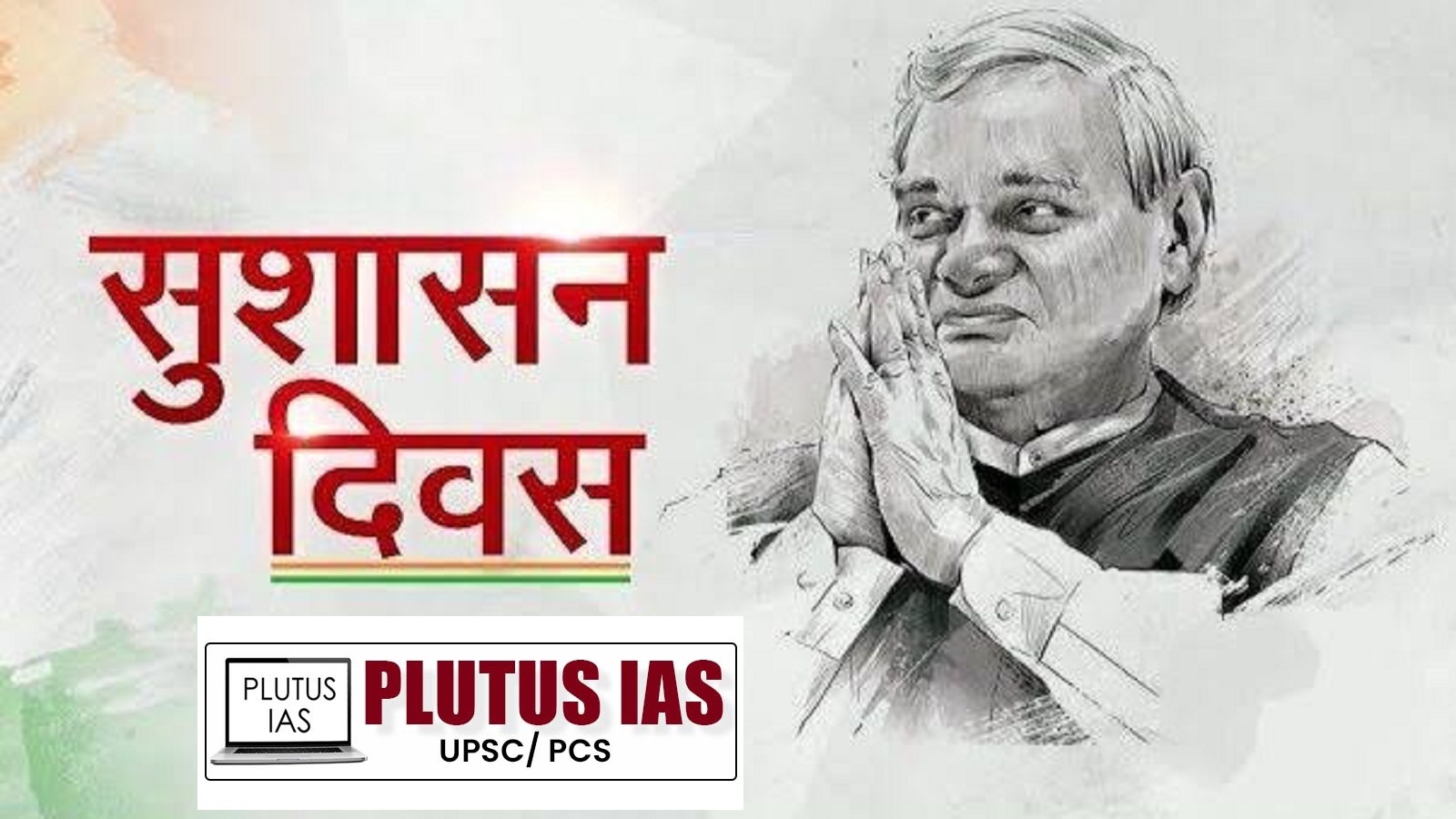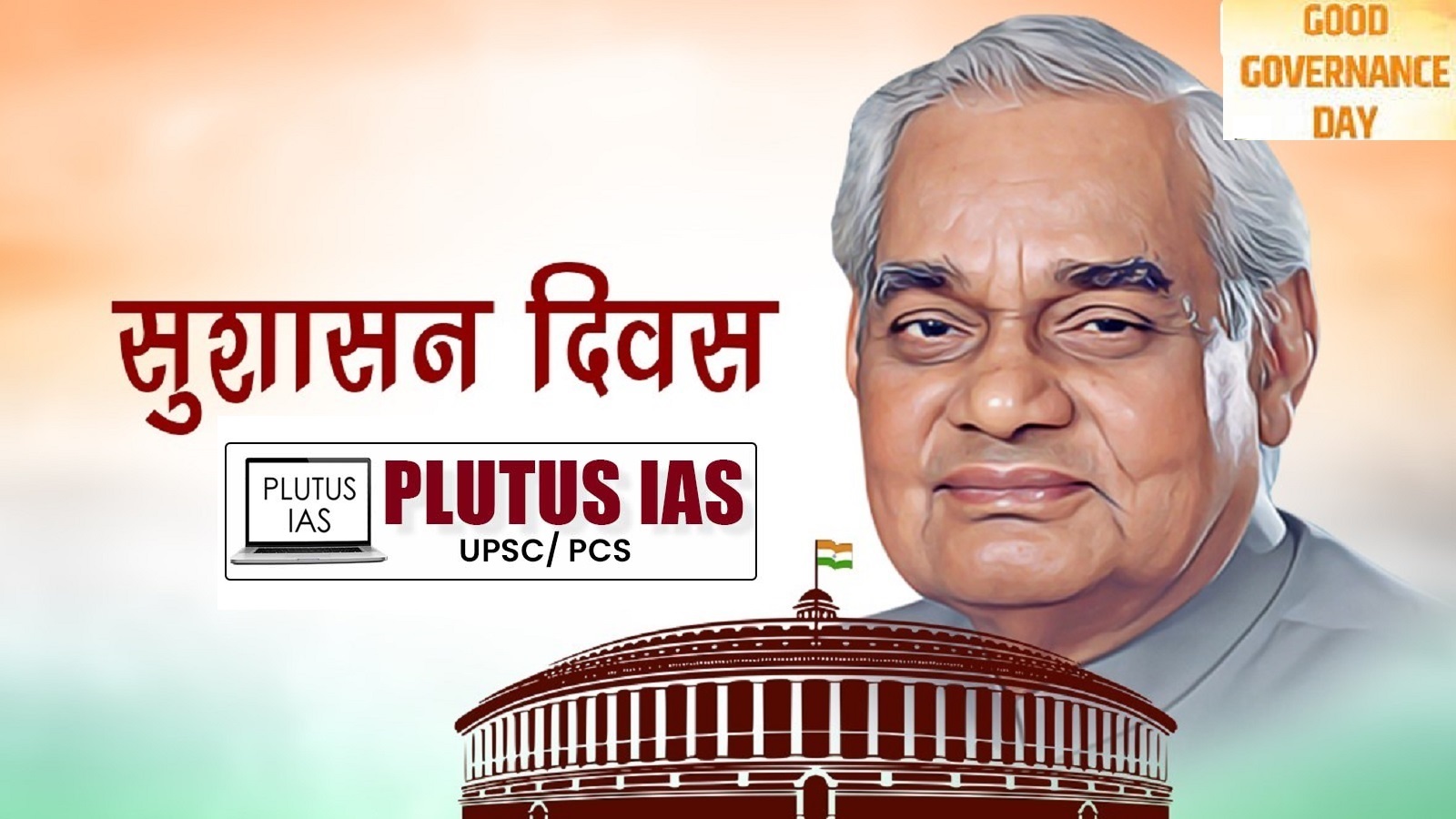21 Aug Good Governance Day
This article covers “Daily Current Affairs” and topic details of the Good governance in India.
Syllabus mapping:
GS 2: Governance: The Governance and various issues related to it.
For Prelims:
Various Initiatives related to the good governance and theme of the good governance Day.
For Mains:
What is good governance in India, Its principles, what issues are related to good governance, and the Way to make good governance feasible?
Why in the news?
Recently, the Prime Minister of India Narendra Modi paid tribute to the former Prime Minister of India Shri Atal Bihari Vajpayee at the ‘Sadaiv Atal’ memorial on the occasion of his death anniversary on 16th August. Prime Minister Modi paid tribute to Vajpayee ji, remembering his contribution and leadership.
Atal Bihari Vajpayee, who was a prominent leader in Indian politics, his birth anniversary (25 December) is celebrated every year as Good Governance Day in India. The purpose of celebrating this day is to remember and carry forward Vajpayee ji’s principles of good governance and the high standards set by him.

What is the Good Governance?
Governance is the process of making decisions and implementing them. Good governance means proper and effective use of power in managing the economic and social resources of the country. Citizen-centric administration is based on the foundation of good governance. This concept has been prevalent since the era of Chanakya, who wrote in his treatise Arthashatra. It has been mentioned in detail.
Principles of good governance:
1. Ensuring everyone’s participation in governance: Under this, citizens should get the opportunity to express their opinions through legitimate organizations or representatives. This includes men and women, weaker sections of society, backward classes, minority communities, etc. Participation in governance also implies freedom of association and expression of citizens.
2. Rule of law: Under this, laws have to be applied fairly and equally for all citizens and the protection of human rights has to be ensured. Without the ‘rule of law’, politics will follow the principle of Matsya Nyaya, which means that the stronger group or community will dominate the weaker section or communities of the society.
3. Consensus-oriented governance: Good governance involves making decisions by consensus so that minimum resources are available to all. It mediates diverse interests to achieve a broad consensus on the best interests of a community.
4. Promoting inclusivity and equality: Good governance promotes the creation of an equitable society in which all citizens should have opportunities to improve or maintain their standard of living.
5. Using Effectiveness and Efficiency: Under this, the resources of the community should be used effectively for maximum production. Which involves making processes and institutions meet the needs of the community and using resources effectively.
6. Ensuring accountability towards citizens: The objective of good governance is the betterment of the people and this cannot be done without ensuring accountability of the government to the people. Accountability to public and institutional stakeholders should be ensured by government institutions, private sectors or institutions, and civil society organizations.
7. Ensuring transparency in good governance: Ensuring transparency in good governance means that information is accessible and understandable to the general public. This means that people are fully informed about their rights and decision-making processes and can monitor them. This includes ensuring free media and overall access to information so that different parts of society can effectively express their views and be monitored.
8. Ensuring transparency and accountability at organizational and procedural levels: Good governance requires decision-making bodies to be accountable for their actions and ensure that all stakeholders receive services in a timely and effective manner. This principle ensures organizational and procedural transparency and accountability.
Obstacles coming in the way of good governance in India:
Women Participation: Women are not adequately represented in government institutions and other allied sectors in India. This inequality not only violates women’s rights but also affects the quality of governance. There is an urgent need for policy reforms and awareness campaigns to increase women’s participation in governance.
Corruption: Corruption is one of the biggest obstacles to good governance in India. High levels of corruption not only hamper economic growth but also undermine public trust. There is a need for strict laws and increased transparency to reduce corruption.
Justice system: Delay in getting justice is a serious problem in India. Due to a lack of personnel and resources in the courts, cases are not disposed of on time. This situation calls for reforms in the justice system, including increasing the number of courts and technological reforms.
Centralization of the administrative system in India: Due to the centralization of governance in India, lower-level governments are not able to function efficiently. Panchayati Raj institutions in particular are facing a shortage of funds and difficulties in carrying out their constitutionally assigned functions. Therefore, there is a great need for decentralization of governance and strengthening of local governments in India.
Criminalization of politics: in India Criminalization of the political process and nexus between politicians, civil servants, and business houses is having an adverse impact on public policy making and governance. Solving this problem requires political reform and strict monitoring.
Other challenges: Challenges of environmental protection, sustainable development, globalization, liberalization, and market economy are also obstacles in the path of good governance. Holistic and balanced policies are needed to address these challenges.
Government initiatives launched to improve good governance in India:

Good Governance Index (GGI): This index has been launched by the Ministry of Personnel, Public Grievances, and Pensions to determine or measure the state of governance in the country. It assesses the impact of various steps taken by the state government and union territories.
National e-Governance Plan: Its objective is to make all government services available locally at affordable prices through ‘Common Service Delivery Outlets’ to meet the basic needs of the common man and to ensure the efficiency, transparency, and reliability of such services.
Right to Information Act, 2005: This Act plays an effective role in ensuring transparency in governance in India. Through this, citizens can get information about government works, due to which corruption can be curbed or reduced.
Make in India Programme: Make in India program has been started to encourage industrial development and investment in the country.
Establishment of NITI Aayog: NITI Aayog has been set up with a new approach to improve policy formulation and implementation in India.
Appointment of Lokpal: It acts as an effective monitoring mechanism against corruption in India.
Various ways to make good governance more feasible in India:
1. Strengthening Institutional Frameworks
Enhance Accountability: Implement robust mechanisms for accountability, including regular audits and transparency in decision-making.
Reinforce Institutions: Strengthen key institutions such as the judiciary, anti-corruption bodies, and regulatory agencies to ensure fair and efficient governance.
2. Improving Transparency and Openness
E-Governance: Utilize digital platforms to improve transparency, streamline processes, and facilitate citizen access to information and services.
Public Disclosure: Ensure timely and comprehensive disclosure of government decisions, expenditures, and policies to foster public trust.
3. Promoting Participatory Governance
Citizen Engagement: Involve citizens in decision-making processes through consultations, public hearings, and feedback mechanisms.
Decentralization: Empower local governments and institutions to make decisions that directly impact their communities, enhancing responsiveness and accountability.
4. Enhancing Efficiency and Effectiveness
Administrative Reforms: Streamline bureaucratic processes to reduce delays and improve service delivery.
Performance Measurement: Establish clear metrics and regular evaluations to assess the effectiveness of government programs and initiatives.
5. Combating Corruption
Anti-Corruption Measures: Implement strict anti-corruption laws and ensure their enforcement. Establish independent bodies to investigate and address corruption cases.
Ethical Standards: Promote a culture of integrity and ethics within public offices and institutions.
6. Fostering Inclusive Development
Equitable Policy Making: Design and implement policies that address the needs of all segments of society, including marginalized and vulnerable groups.
Social Welfare Programs: Strengthen social safety nets and welfare programs to ensure that the benefits of development reach the underprivileged.
7. Encouraging Innovation and Technology
Technology Adoption: Leverage technology to enhance governance processes, improve data management, and deliver services more efficiently.
Innovation Hubs: Create platforms for innovation in governance practices and public administration.
8. Building Capacity and Skills
Training and Development: Invest in the training and professional development of public officials to enhance their skills and effectiveness.
Knowledge Sharing: Foster knowledge sharing and best practices among different levels of government and between public and private sectors.
Conclusion
Achieving good governance in India is essential for fostering sustainable development and ensuring equitable progress. By strengthening institutional frameworks, enhancing transparency, and promoting participatory governance, India can build a more responsive and accountable system. Combating corruption, encouraging technological innovation, and focusing on inclusive development are crucial for creating a governance model that benefits all citizens. With a concerted effort to streamline administrative processes and invest in capacity building, India can realize its vision of effective and efficient governance, paving the way for a more just and prosperous society.
Prelims Question:
Q.1. Consider the following:
1. Ensuring everyone’s participation in governance
2. Rule of law
3. Ensuring accountability to citizens
4. Ensuring transparency and accountability at organizational and procedural levels
How many of these are principles of good governance?
(a) Only one
(b) Only two
(c) Only three
(d) All Four
Answer – d
Mains Question
Q.1. Discuss how good governance can be used effectively to address the various challenges India faces towards achieving its goal of becoming a developed country by 2047.
(250 words 15 marks)
About Atal Bihari Vajpayee:
- Atal Bihari Vajpayee was born on December 25, 1924, in Gwalior (present Madhya Pradesh).
He entered national politics during the Quit India Movement of 1942, which was an important step towards the end of British colonial rule. - In 1947, Vajpayee ji started working as a journalist for Deendayal Upadhyay’s newspapers.
- He also contributed to Rashtra Dharma (a Hindi monthly), Panchjanya (a Hindi weekly), and dailies such as Swadesh and Veer Arjun.
- Inspired by Shyama Prasad Mukherjee, Vajpayee joined the Bharatiya Jana Sangh in 1951.
He was the former Prime Minister of India and was elected as the Prime Minister of India twice in 1996 and 1999. - As an MP he was awarded the Pandit Govind Ballabh Pant Award in 1994, which “A role model for all MPs” Recognizes.
- He was awarded the Bharat Ratna, the country’s highest civilian honor, in 2015, and the Padma Vibhushan, the second-highest civilian honor, in 1994.
Atal Bihari Vajpayee Ji died on August 16, 2018.



No Comments